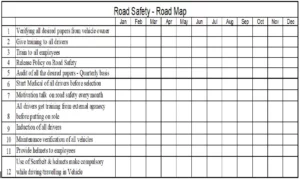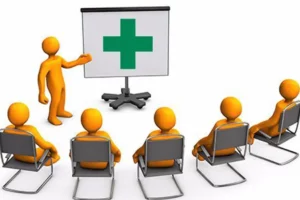Road Safety
Road Safety means driving vehicle on roads with a consciousness of safety, but it does not means only road
HSE Guidelines on Road Safety
- The Person operating the vehicle must comply with the rules & regulations laid down in “The Motor Vehicle Rule 1988.
- Relevant policies, procedures, protective equipment, and documentation are provided to new drivers during induction.
- A process should be in place to conduct driving license checks for all new and existing drivers.
- A system should be in place to maintain appropriate driver records, including copies of employment applications, medical/health information, reference checks, training records and qualifications, accident history.
- Before being assigned a vehicle, checks are made on the extent to which the employee has driven that type and size of vehicle before.
- Drivers are assessed on their knowledge of Motor Vehicle Act’1988 such as signage, road safety etc.
- Drivers understand that they must immediately inform their supervisor of any health or wellbeing issues affecting their ability to drive safely.
- A driver must not continue his services more than 10 hours in a day so that it should not lead to excessive fatigue & stress.
- Use of Alcohol and drugs are strictly prohibited during driving of a vehicle
- The drivers who are taking medicine that might impair their driving performance must not drive vehicle.
- Eyesight should be checked of each driver once in every two years & at the beginning of the job.
- Use of mobile phones is strictly prohibited while driving.
- Driver must use seat belt while driving.
- There should be a clear vehicle selection, allocation, and replacement policy covering vehicle construction, driver and vehicle safety, fuel efficiency and environmental performance standards.
- There should be an appropriate program for planned vehicle maintenance, with detailed records maintained on all vehicles, distinguishing between both planned and unscheduled maintenance, and collision damage.
- Maintenance, repairs and modifications to fleet vehicles are conducted and administered by competent mechanics, complying with manufacturer and legal specifications as a minimum standard.
- All minor/major accidents should be reported to Company management & appropriate corrective and preventive action should be taken to avoid reoccurrence
- All vehicle should accommodate only that number of persons which is approved by State Road Transport
- Speed of the vehicle shouldn’t exceed 80 km/hr on any instance.
- All the vehicles entering in Company premises should have valid Pollution Under Control (PUC) certificate
- Drivers should follow all the Company Safety & Environment rules inside the company premises.
DO YOU KNOW?
- 85,000 people killed in 4.5 lakh accidents REPORTED on Indian Roads every year
- Almost 215 killed daily
- Immeasurable social & emotional cost of accidents
- Road accidents lack glamour of air /ship rail disasters and hence do not affect people’s psyche greatly.
- Our commitment should be to ensure that our activities do not pose a threat to own employees, contractors’ workers and to public.
Some chilling facts:
- Head on accidents followed by rear end collision – 70%
- 65% accidents are due to rash & negligent driving
- 70% die on the spot & 7% on way to the hospital
- One death every 2.75 minutes on Indian roads
- Accidents per 1000 vehicles in India is 14 against 5 in most of the countries
- Two wheelers – the most unsafe vehicle is 72% of entire vehicle population in India
Five Worst Habits of Indian Drivers
- Lane Cutting
- Jumping Signals
- Speeding
- Rash Overtaking
- Drunken driving
Helmets
People say helmets are expensive, but is it more expensive than life?” Over 75 per cent of cases are two- wheeler related. Head injuries are common because helmets are not worn.
SEAT BELTS
The difference between the belted person’s stopping distance and the unbelted person’s stopping distance is significant.
IT IS THE DIFFERENCE BETWEEN LIFE & DEATH .
A loose seat belt is as good as no seat belt.
Be A Defensive Driver
- Do not overtake if in doubt .
- Let someone else do the driving if you
- have to drink.
- Overtake only from right.
- Never jump the red light, It may cause
- your life.
- Two wheelers are meant for two persons
It is better to be safe than sorry!!!!!
Oath: Road Safety
- Biggest enemies of road Safety is Liquor, Speed & Overload —- Avoid It.
- Midway crossing is dangerous to life — Avoid It.
- Don’t ride with children in your lap. -Never Never.
- Lane driving is safe driving. — Do It.
- Never jump the red light, It may cause your life.
- Life is a game – Play it, but not on the road.
- Let’s take OATH to be a Defensive driver, obey all
Road Safety Signs (Road Signs) & Save the life of people on road accidents.


Usefull Blog for Your
First Aid Training Topics – Click Here
Compressed Gas Cylinder Safety – Click Here



